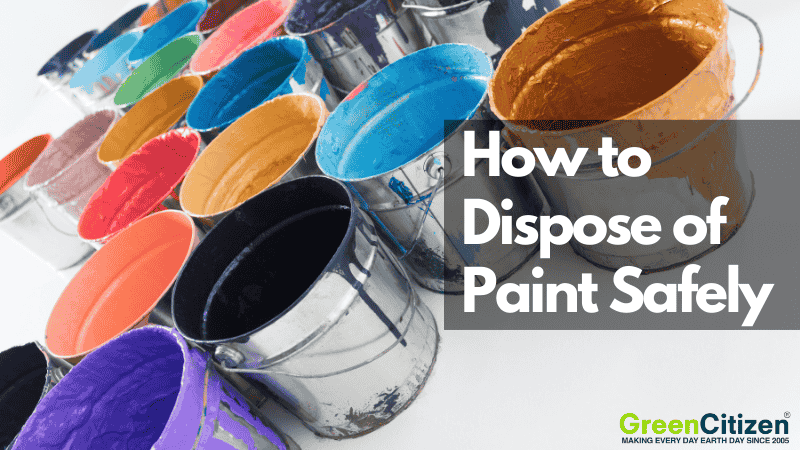We’ve all been there—whether it’s after a home remodeling project or an afternoon spent on a DIY craft, you’re left with half-empty paint cans sitting in your garage. You know the paint can’t just be tossed into the trash—it’s toxic and poses risks to the environment. But where do you even start? With so many rules and regulations, figuring out how to dispose of paint safely can feel overwhelming.
Old paint, especially from previous projects, tends to accumulate over the years, making the situation even more daunting. It’s not just about finding space to store these leftover cans, but understanding the environmental and legal consequences of improper disposal.
Tossing paint in the trash or pouring it down the drain can harm local ecosystems, not to mention, many places have strict laws against improper disposal.
This is why knowing how to recycle or dispose of old paint the right way is crucial. In this guide, we’ll break down the steps to safely and responsibly handle paint disposal, so you can finally clear out those old cans without worry.
Types of Paint and How to Dispose of Them
When it comes to disposing of paint, understanding what type you’re dealing with is crucial. Each paint type contains different chemicals and requires specific disposal methods.
Disposing of them improperly can lead to harmful environmental consequences, so it’s essential to know which paints can be recycled, thrown in the trash, or need special handling at hazardous waste collection points. Additionally, knowing how to handle paint left after a project is important for responsible disposal practices.
1. Latex Paint: How to Dispose of It
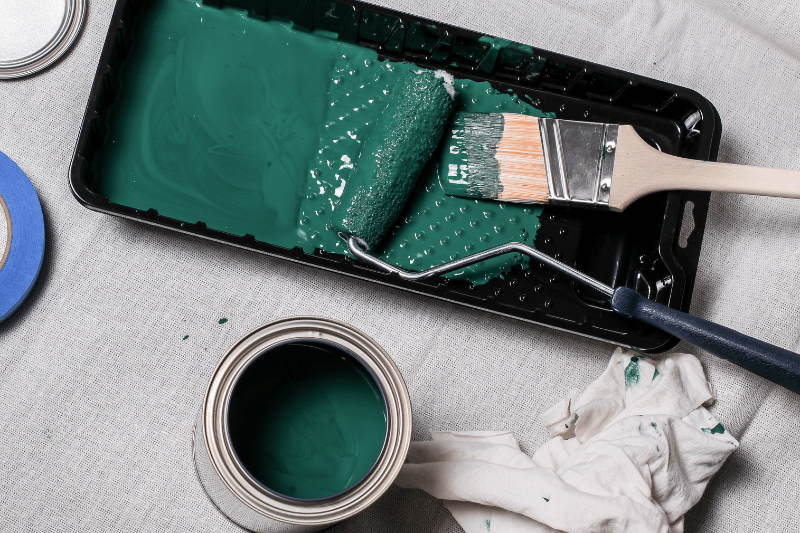
Latex paint, commonly used for walls and ceilings, is water-based and contains fewer harmful chemicals than oil-based alternatives.
Latex paint includes compounds like titanium dioxide and ethylene glycol, which, while less toxic, can still harm the environment if not disposed of correctly. Fortunately, latex paint can often be dried out and then disposed of with regular trash.
Latex Paint Disposal Method
If you only have a small amount of liquid paint left, simply remove the lid and allow the paint to dry completely. You can speed up the drying process by mixing in materials like kitty litter or sawdust. Once the paint is dry, it can be safely tossed in the trash. Local recycling programs may accept larger quantities.
2. Oil-Based Paint: Hazardous Waste Disposal
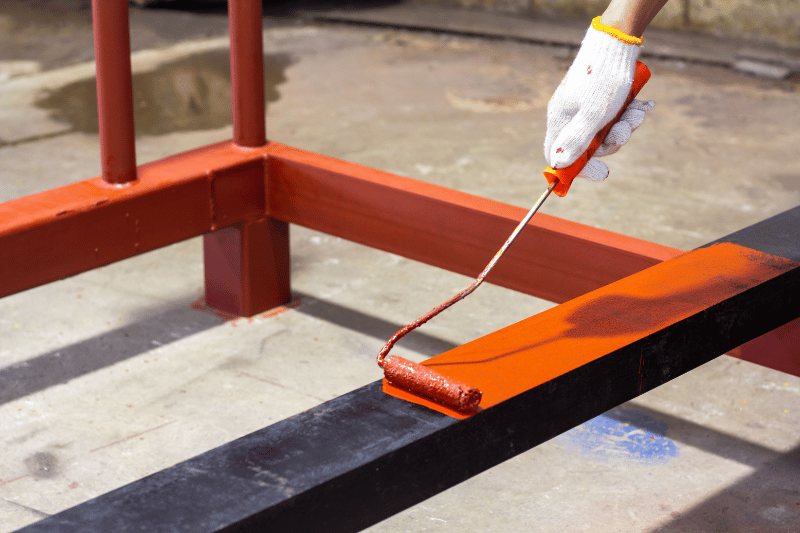
Unlike latex paint, oil-based paint is classified as hazardous waste due to its high levels of volatile organic compounds (VOCs), such as toluene, xylene, and benzene. These chemicals can release toxic fumes and contaminate soil and groundwater if not disposed of properly.
Oil-Based Paint Disposal Method
Never throw oil-based paint in the trash. It must be taken to a designated Household Hazardous Waste collection (HHW) facility. Many local government websites provide information on where to drop off oil-based paint, and some retailers may also have take-back programs.
3. Acrylic Paint: Safe Disposal

Acrylic paint, often used for crafts and art projects, is similar to latex paint in that it’s water-based, but it still contains pigments and polymers that can harm the environment if disposed of improperly.
Acrylic Paint Disposal Method
Like latex paint, acrylic paint can be dried out and disposed of with regular household trash once solid. However, recycling programs may also accept it, so check with your local waste management services.
4. Spray Paint and Aerosol Paint Cans: Special Handling
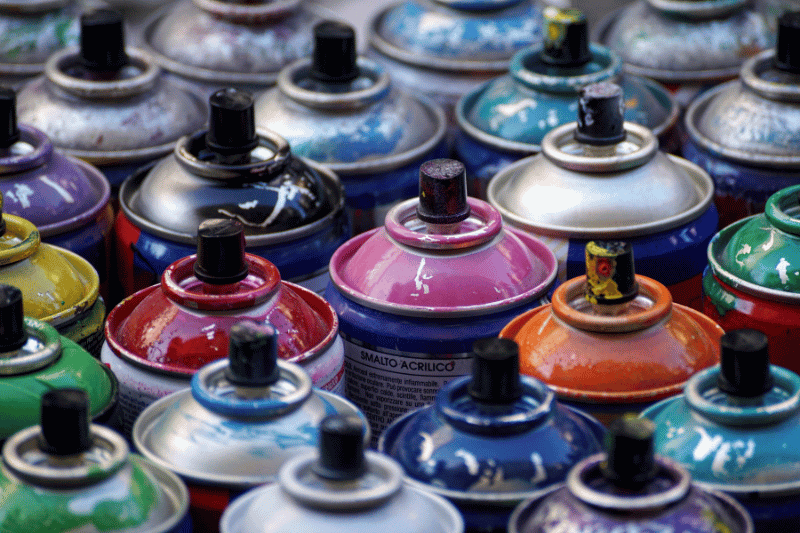
Spray paints and aerosol paint cans present a unique challenge due to their pressurized containers and hazardous chemicals, such as hydrocarbons and chlorofluorocarbons (CFCs). If released, these chemicals can be harmful to the environment and human health.
Spray Paint and Aerosol Paint Cans Disposal Method
Aerosol cans should never be thrown in the regular trash, especially if they still contain paint. Most recycling centers won’t accept partially filled aerosol cans. Empty cans can often be recycled with regular curbside recycling programs, but for partially full or pressurized spray paint cans, you’ll need to take them to a hazardous waste collection point.
Checking Paint Condition Before Disposal
Before disposing of paint, it’s essential to check its condition. If the paint is still usable, consider donating it to a local community theater, school, or non-profit organization. This not only helps reduce waste but also supports community projects.
To determine if the paint is still good, check its consistency, color, and smell. If the paint is smooth and free of lumps, and there’s no foul odor, it’s likely still usable. If the paint is dried out or has gone bad, it’s best to dispose of it properly according to local regulations.
Proper assessment can help you decide whether to keep, donate, or dispose of the paint.
Where to Dispose of Old Paint Near You
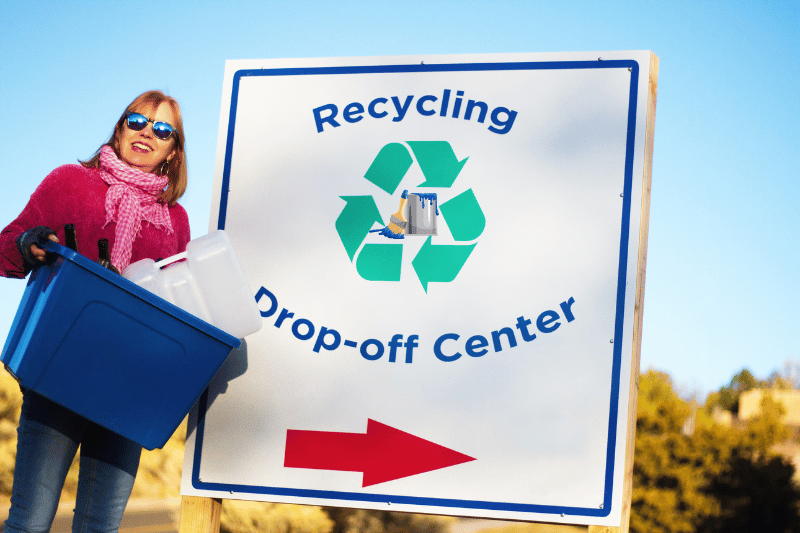
Disposing of old paint can be challenging due to environmental and legal concerns, but finding the right solution is easier than you think. Whether you’re in a large city like San Francisco or elsewhere, several options are available for paint disposal near your location, including using a recycling center.
1. Local Paint Drop-Off Locations
Most cities have designated paint drop-off centers where residents can safely dispose of leftover paint. For example, Recology in San Francisco provides several convenient drop-off locations for household hazardous waste.
Local recycling centers might accept small quantities of dried latex paint if you want to recycle paint. Searching for old paint disposal near me on your local government or waste management website will help you find the nearest center. Additionally, consider donating surplus paint to a local theater, which can benefit from community support for their projects.
2. Household Hazardous Waste (HHW) Facilities
If you’re dealing with hazardous materials like oil-based paint, make sure to take them to a certified household hazardous waste facility. These facilities are designed to handle dangerous materials that can’t be thrown away with regular trash. Many cities provide these services on specific days or through local waste management programs. A quick search for dispose of old paint near me should lead you to the right facility in your area.
3. Hardware Store
Some large hardware stores, like Home Depot and Lowe’s, participate in paint drop-off programs that help consumers safely dispose of unwanted or unused paint.
These stores often collaborate with organizations like PaintCare, which runs take-back programs across the country. You can visit PaintCare’s website to find participating retailers near you, making it easy to safely get rid of your old paint while running your errands.
Preparing Paint for Disposal
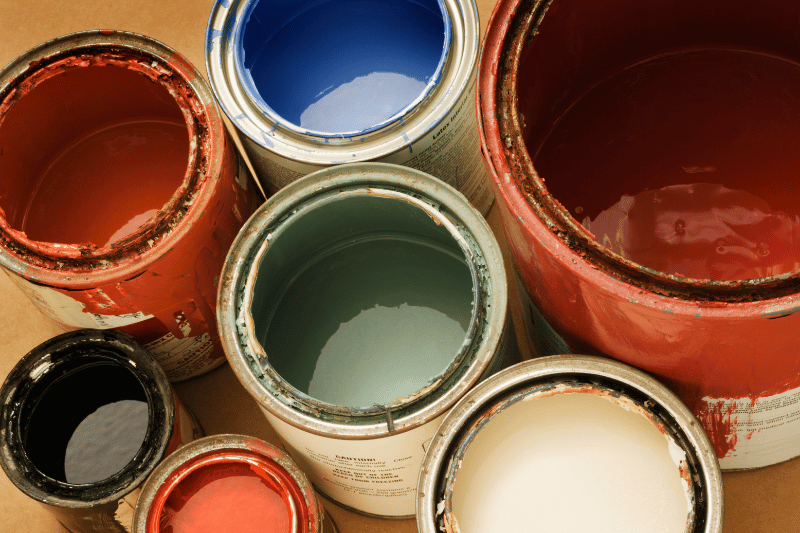
Before you dispose of your old paint cans, it’s important to ensure any paint left is properly prepared. Depending on the type of paint you have—whether it’s latex, acrylic, or oil-based—the preparation process varies. Properly drying or containing paint prevents it from leaking or causing environmental damage during disposal.
Drying Out Latex or Acrylic Paint
For water-based paints like latex or acrylic, drying out the paint is an easy way to prepare it for disposal. If you only have a small amount of paint water left in the can, leaving the lid off will allow the liquid to evaporate. For larger quantities, mix in materials like kitty litter or sawdust to speed up the drying process. Once the paint has completely solidified, the empty paint cans can typically be thrown away with your household trash.
Tip: Make sure that the paint is fully dry before placing the empty cans in the trash. In some cities, empty paint cans can also be recycled, so check with your local recycling program.
Handling Old or Hardened Paints
If your paint is already hardened or dried up, disposal becomes easier. Old paint cans that no longer have any usable liquid can usually be thrown away in your regular garbage. However, if the paint is still somewhat soft, you can finish the drying process before tossing it.
Some paints, especially oil-based, should never be dried out and disposed of in the trash. For these, take them to a hazardous waste facility to avoid environmental harm.
Tip: Avoid pouring any paint water down the drain, as it can cause clogs and contaminate water systems. Always aim to let paint dry before disposal.
How to Store and Handle Paint Cans
Proper storage and handling of paint cans are crucial to prevent accidents and ensure safety. Store paint cans in a cool, dry place, away from direct sunlight and heat sources, to maintain their quality.
Make sure the cans are sealed properly to prevent leakage and contamination. Use a rubber mallet to tap the lid down securely, avoiding a hammer that can dent the lid. Label the cans with the paint’s brand, name, date of purchase, mixture number, and the room painted.
This makes it easier to identify the paint for future touch-ups or projects. Consider using a label maker to mark each room on the shelf front for easy access and organization.
Disposing of Paint Cans
Once the paint is gone, you’re left with the paint cans—and it’s important to dispose of them properly. Depending on whether the cans are empty or still contain paint, the disposal process will differ. Here’s a guide on what to do with both empty paint cans and those that still have leftover paint inside.
1. Recycling Empty Paint Cans
If your paint cans are completely empty and dry, they can often be recycled just like other metal containers. Many curbside recycling programs accept empty paint cans, as long as they’re fully dry and have no residual paint inside. Check your local recycling guidelines to ensure they accept metal paint cans.
Tip: Before recycling, make sure the can is clean and dry. Remove any labels if possible to improve the chances of it being accepted by recycling facilities.
2. Disposing of Non-Empty Paint Cans
If your paint cans still contain leftover paint, whether it’s a small amount or almost full, they must be handled differently. For non-empty cans, especially those containing oil-based paint, it’s essential to take them to a hazardous waste collection facility. Pouring leftover paint into the trash or down the drain is harmful to the environment.
Can You Dispose of Paint in the Trash? (What NOT to Do)
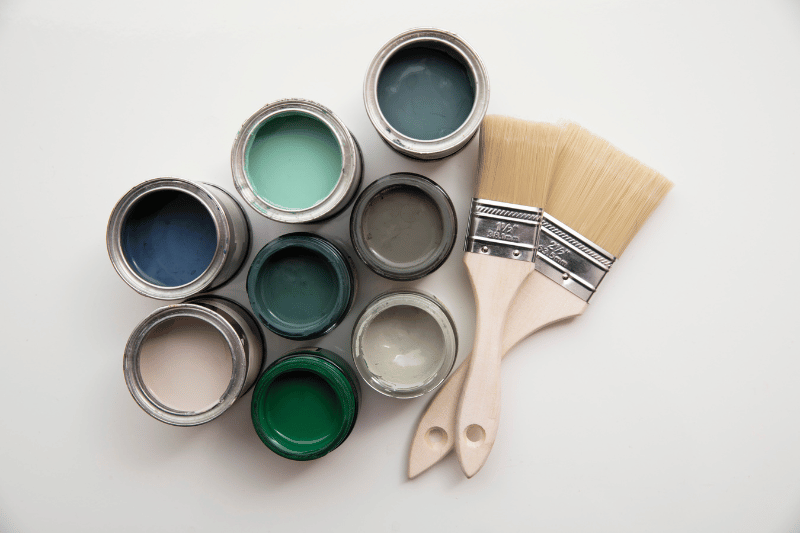
For latex paint and acrylic paint, it’s safe to throw them in the trash, but only after they have completely dried out. To speed up the process, you can leave the lid off or mix the paint with an absorbent material like kitty litter. Once solidified, you can throw away these empty paint cans with your regular trash.
However, oil-based paint and paints in aerosol cans should never be thrown in the trash. These contain hazardous chemicals that can damage the environment and may even be illegal to dump in some areas. Instead, you must take them to a household hazardous waste facility or search online for “where can I dispose of paint” to find a safe paint drop-off location near you.
To reduce waste, consider recycling or donating usable paint. Many communities offer programs where you can get rid of old paint responsibly or find creative ways to upcycle it for small projects.
Responsible Paint Disposal and Environmental Impact
Improper disposal of old paint can have serious environmental consequences. Paints, especially oil-based paint, contain hazardous chemicals like volatile organic compounds (VOCs) that can contaminate soil, water, and air.
When these harmful substances are thrown away improperly or dumped down drains, they can cause lasting damage to ecosystems and even pose health risks to communities.
That’s why it’s essential to prioritize responsible paint disposal. By taking leftover paint to local recycling programs or hazardous waste collection centers, you prevent these toxins from entering the environment.
Many communities offer convenient options for paint disposal near me, making it easier than ever to safely dispose of old paint. Whether it’s dropping off unused cans or ensuring oil-based paint is handled by a hazardous waste facility, every effort contributes to a healthier planet.
Remember, proper disposal isn’t just about getting rid of paint—it’s about protecting the environment for future generations.
So, the next time you’re wondering how to deal with old paint, be sure to seek out responsible options and keep harmful chemicals out of landfills and waterways.
Frequently Asked Questions (FAQ)
Once opened, paint can last 2 to 5 years if properly sealed and stored in a cool, dry place. Latex and acrylic paints generally last longer than oil-based paints. To check if the paint is still usable, stir it well and test a small amount on a surface. If the texture is smooth and there’s no bad odor, it’s likely still good.
To harden paint for disposal, add absorbent materials like kitty litter, sawdust, or a commercial paint hardener to the can. Stir the mixture until it thickens. Once the paint has solidified, it’s safe to throw away with regular trash. Be sure the paint is completely dry before disposing of it to prevent leakage.
If the paint is dried out or hardened, you can safely dispose of the old paint cans with your regular trash. However, if there is still paint inside, take the cans to a household hazardous waste facility or a designated paint drop-off center. Some areas also have paint recycling programs available.
Painted tin cans can be recycled, but only if they are completely dry and free of any residual paint. Many curbside recycling programs accept metal paint cans, provided they are clean. For cans with wet or partially dried paint, take them to a hazardous waste facility for proper disposal.
Paint does not decompose easily, especially if it contains hazardous chemicals. Oil-based paint and other solvent-based paints can remain harmful for decades, while water-based paints like latex decompose more quickly. Still, improper disposal can lead to long-term environmental damage, so always follow proper disposal methods.
Yes, certain types of paint, particularly oil-based paint, are considered toxic waste due to their hazardous chemicals like VOCs (volatile organic compounds). These chemicals can pollute the environment if improperly disposed of. Water-based paints like latex are less toxic but still require careful disposal to avoid contamination.
Paint can remain harmful as long as it contains active hazardous chemicals, particularly in the case of oil-based paints. Leftover VOCs in the paint can continue releasing harmful fumes for years. Even dried paint can cause harm if it contains lead or other toxins, especially when disposed of improperly.

